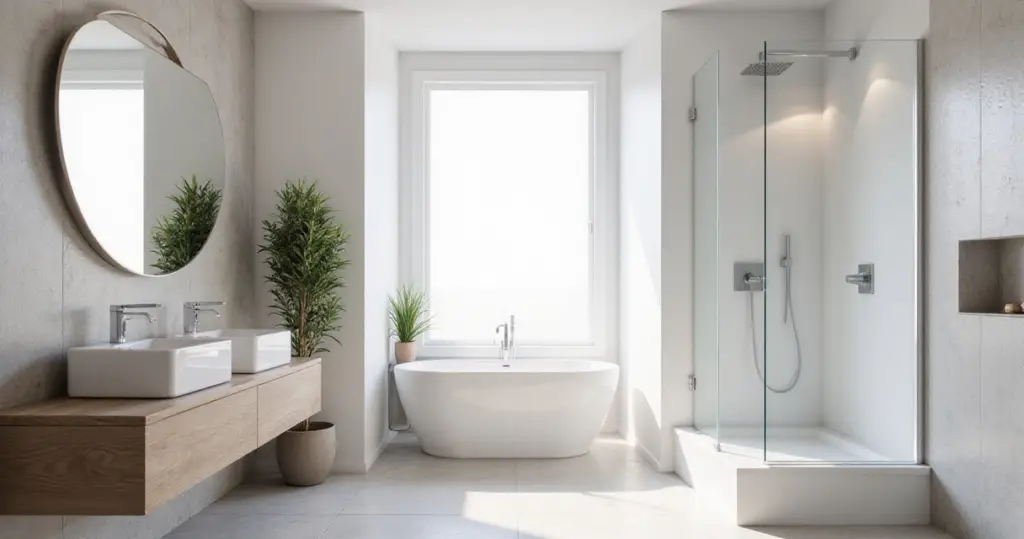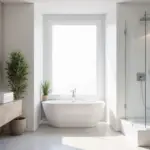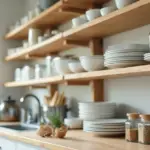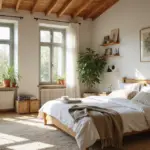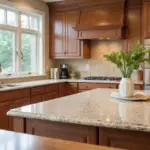You know what people always ask me? “Kai, how do I get that serene, minimalist bathroom look without it feeling like a cold, empty hospital room?” They see pictures online, all white and concrete, and they think modern means sterile. It’s a huge misconception.
They’re chasing an aesthetic without understanding the principle behind it. True modern design, especially when infused with a bit of ancient wisdom, isn’t about emptiness. It’s about quiet. It’s about creating a space so intentionally calm and functional that it gives your mind a place to rest, even while you’re rushing to get ready for a video call. This isn’t about just picking out expensive fixtures. It’s about building your own personal sanctuary—a place to begin and end your day with clarity, not chaos.
So let’s cut through the noise. Here’s what actually matters.
Laying the Foundation for Modern Aesthetics
Everything starts with the invisible structure. Before you even think about a faucet, you have to understand the space and how you move through it. This is about creating a sense of calm from the ground up.
1. Embrace Minimalist Design for Serene Openness
Everyone thinks minimalism is about getting rid of your stuff. It isn’t. It’s about getting rid of the distractions. The Japanese have a concept for this: Kanso, which means simplicity or the elimination of clutter. When your bathroom is packed with bottles, decorative soaps, and extra towels, your eye doesn’t know where to land. Your brain has to process all of it, and that’s a low-level drain on your mental energy every single time you walk in.
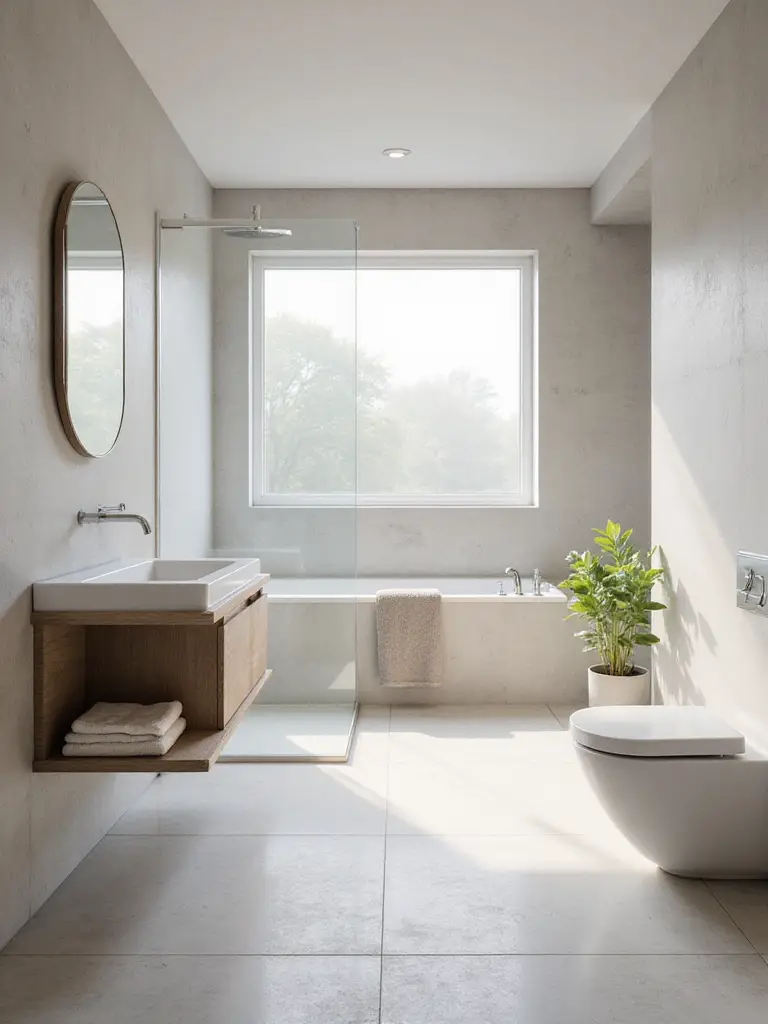
By removing the non-essential, you’re not creating a void. You’re creating clarity. The goal is to walk in and feel your shoulders drop because the space is asking nothing of you. You want a clear counter, a simple color palette, and only the most necessary objects in sight. This single change can make a small bathroom feel vast, because you’re giving your mind, and your eyes, room to breathe.
From this foundation of calm, we can begin to define the space with precision and order.
2. Define Clean Lines to Achieve Sharp Architectural Focus
Once the clutter is gone, you can see the room’s bones. Clean lines are about honoring that structure. Think straight, uninterrupted lines in your vanity, your tile, and your shower. Every edge has a purpose. It’s not about being harsh; it’s about creating a deliberate visual path that is predictable and peaceful for the eye to follow. Where the eye goes, the mind follows.

A client of mine had a bathroom that was perfectly nice, but it was visually busy. The vanity had curved legs, the mirror had an ornate frame, the shower door had thick metal trim. We replaced these with a floating vanity, a frameless mirror, and a seamless glass shower panel. Nothing else changed, but the room felt completely transformed. It went from a collection of objects to a single, unified space. It felt calm because it finally felt resolved.
These lines form the framework, but how you arrange them determines how you use the space.
3. Optimize Layouts for Uncluttered Functionality and Flow
You have a path you walk in your bathroom every single morning: door to toilet, to sink, to shower. A good layout makes this path effortless. The Japanese word nagare means flow, and that’s exactly what we’re creating. There should be no awkward corners to squeeze past, no vanity door that blocks the way when open. This isn’t just about convenience; it’s about removing subconscious friction from your daily ritual.
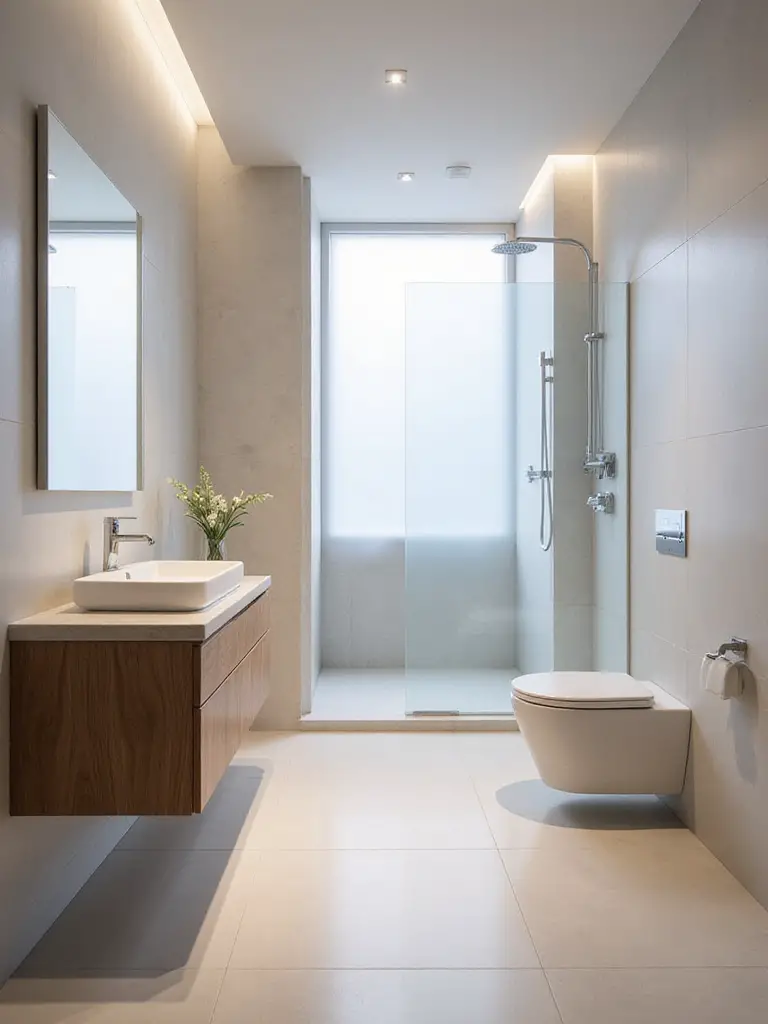
Think about the “work triangle” they use in kitchen design. Your bathroom has one too, between the sink, toilet, and shower/tub. Make sure you have clear, open space between these key zones. A well-designed layout anticipates your movements. I once had a client whose architect placed the towel rack across the room from the shower. It was a beautiful, expensive bathroom, but they dreaded getting out of the shower every day. It was a failure of flow. Don’t let that happen.
A perfect layout is useless, however, if the objects within it don’t serve your daily life.
4. Prioritize Function-First Design for Daily Utility
Here’s the biggest piece of BS in design: that you have to choose between beauty and function. A truly well-designed space is beautiful because it is functional. Before you choose a single thing based on looks, do a “routine audit.” Where do you do your makeup? Where does your electric toothbrush need to charge? Where do the wet towels go? Design for that.
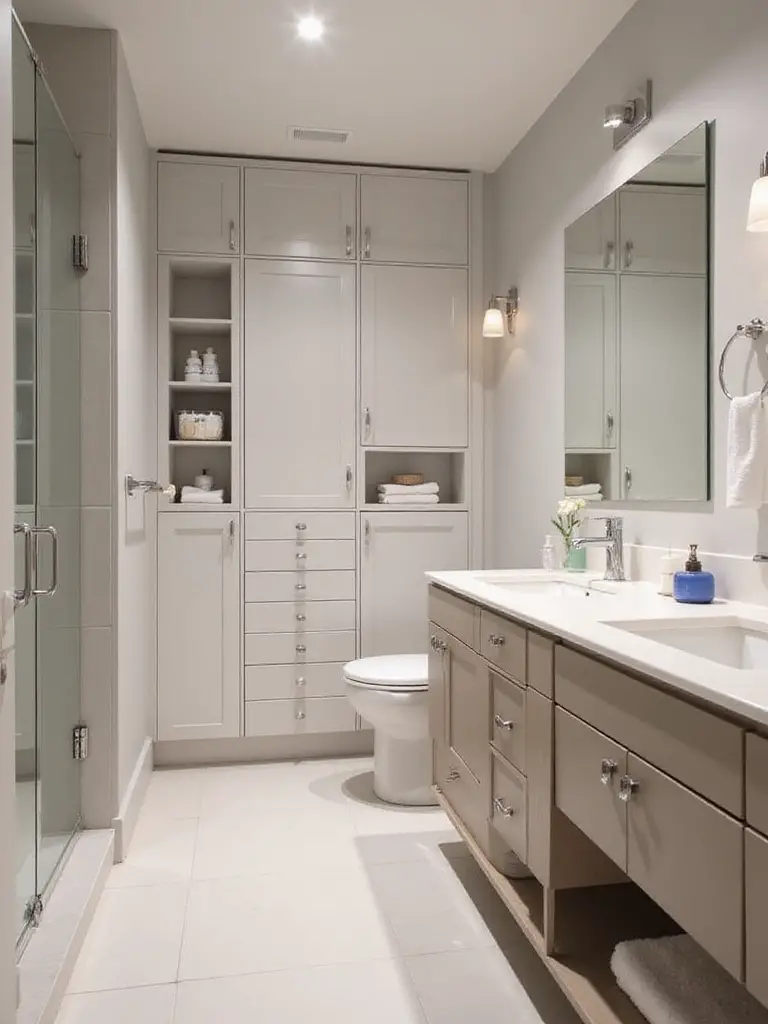
I had a client who was ready to spend a fortune on a stunning vessel sink. I asked him to pretend to wash his face over it in the showroom. It was an ergonomic nightmare—he was splashing water everywhere and had to bend uncomfortably. We switched to a sleek, undermount sink that was just as beautiful but infinitely more practical for his life. A beautiful bathroom you hate to use is a failed design. The ultimate luxury is effortless function.
This function then gets wrapped in a calming visual language, starting with your color choices.
5. Create a Neutral Base Palette for Timeless Sophistication
People hear “neutral” and think “boring.” Let’s reframe that. A neutral palette isn’t the main event; it’s the quiet stage that allows the real stars—light, texture, and you—to shine. Think of colors like off-white, soft grey, greige, or warm beige. These hues create a serene backdrop (shibui, or quiet taste) that doesn’t scream for attention.
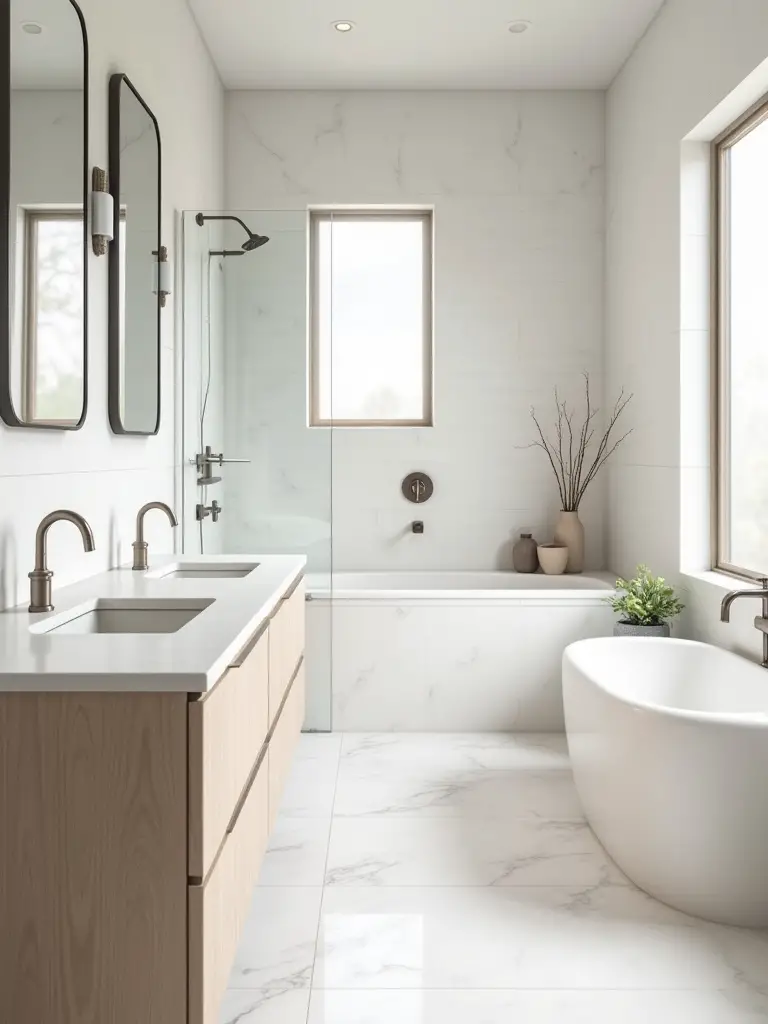
This approach also has a very practical benefit: timelessness. A bathroom tiled in trendy navy blue will look dated in five years. A bathroom in a beautiful, warm grey will look elegant for decades. You can easily change the feel of the room by swapping out towels, a bathmat, or a piece of art. A neutral base gives you a foundation of calm and the flexibility to evolve, saving you the immense cost and hassle of a future renovation.
Now that the stage is set, let’s choose the materials that will bring it to life.
Mastering Modern Materials & Textures
This is where the soul of the room comes from. The interplay of texture and material is what turns a simple design into a rich sensory experience.
6. Choose Large Format Tiles for Seamless, Expansive Walls
I love large format tiles for one simple reason: they reduce visual noise. A standard 4×4 tile creates a busy grid of grout lines. Your eye registers every single one of those lines. A large 24×48 tile creates a smooth, continuous surface that makes a wall feel like a single, monolithic plane. It immediately makes a room feel larger and more serene.
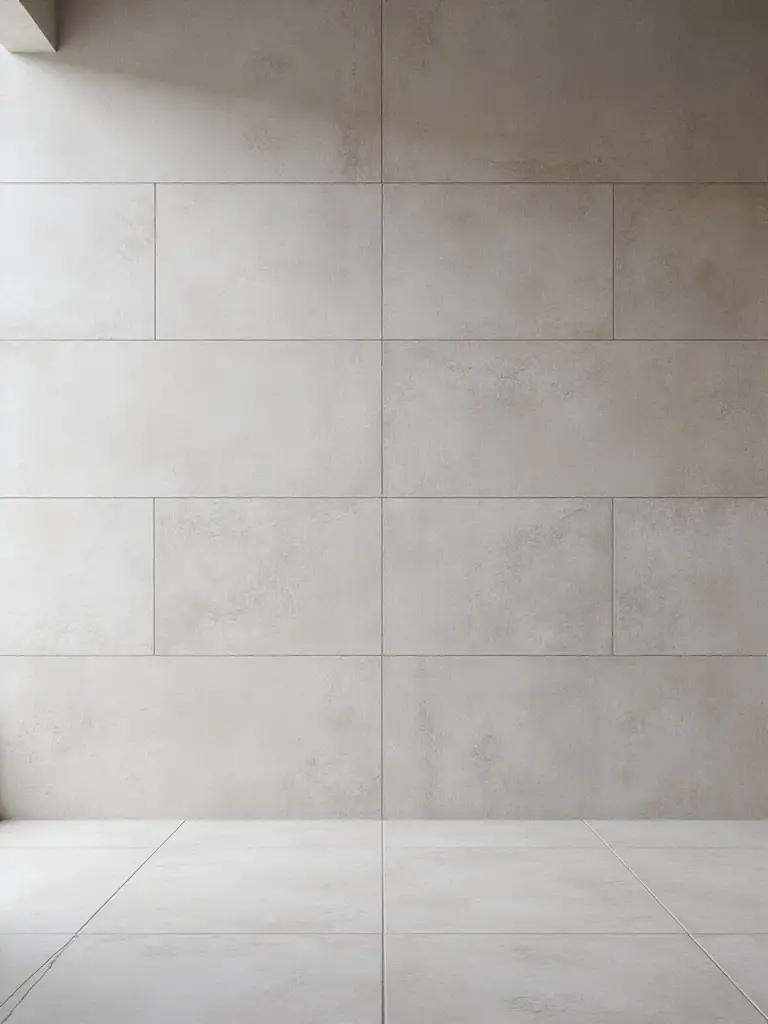
The shortcut here is something contractors often won’t tell you until it’s too late: you must use a tile leveling system. These little clips and wedges are non-negotiable for large tiles. They mechanically pull the tiles flush with each other as the mortar sets, preventing “lippage”—where one tile edge is higher than its neighbor. Without them, you’ll end up with an uneven surface that casts tiny, annoying shadows, completely ruining the seamless effect you were trying to create.
These clean surfaces create the perfect canvas to introduce materials with soul and warmth.
7. Integrate Natural Materials to Add Organic Warmth
This is the secret to keeping a modern bathroom from feeling cold. It’s the principle of shizen—connection to nature. We are organic beings, and we feel a deep, instinctual comfort when surrounded by natural materials. A touch of wood, whether it’s a teak bathmat or a white oak vanity, brings immediate warmth and life. A stone countertop or a slate floor grounds the space.
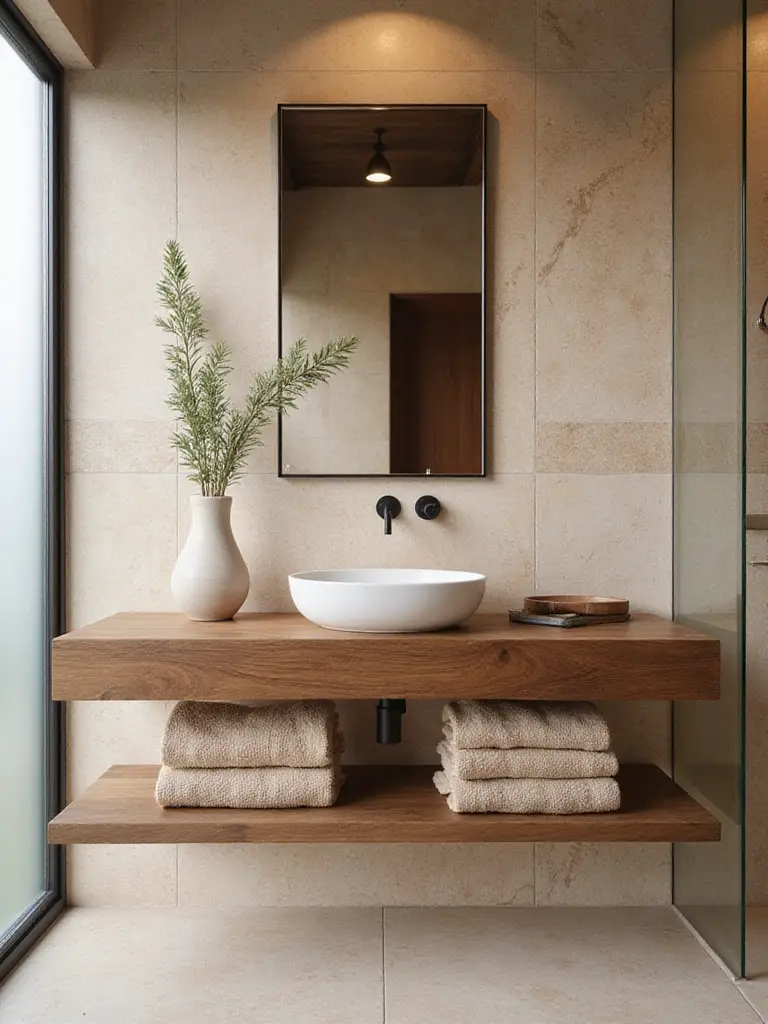
I remember designing a bathroom that was all cool greys and white porcelain. It was technically perfect but felt sterile. We added one simple thing: a custom-made floating vanity from a single slab of reclaimed walnut. The wood’s rich grain and warm tone changed everything. It became the heart of the room, a touch of nature that made the entire space feel balanced and human.
That balance of materials is made even more sophisticated with the right finish.
8. Select Matte Finishes for Subtle, Contemporary Sophistication
In a world full of glossy screens, matte finishes offer a moment of visual quiet. A glossy surface reflects light and everything around it, creating a busy, fractured image. A matte surface absorbs light, creating a soft, deep, and unified look. Think about matte black faucets, honed (not polished) marble, or a flat-finish paint. They invite touch and feel incredibly luxurious.
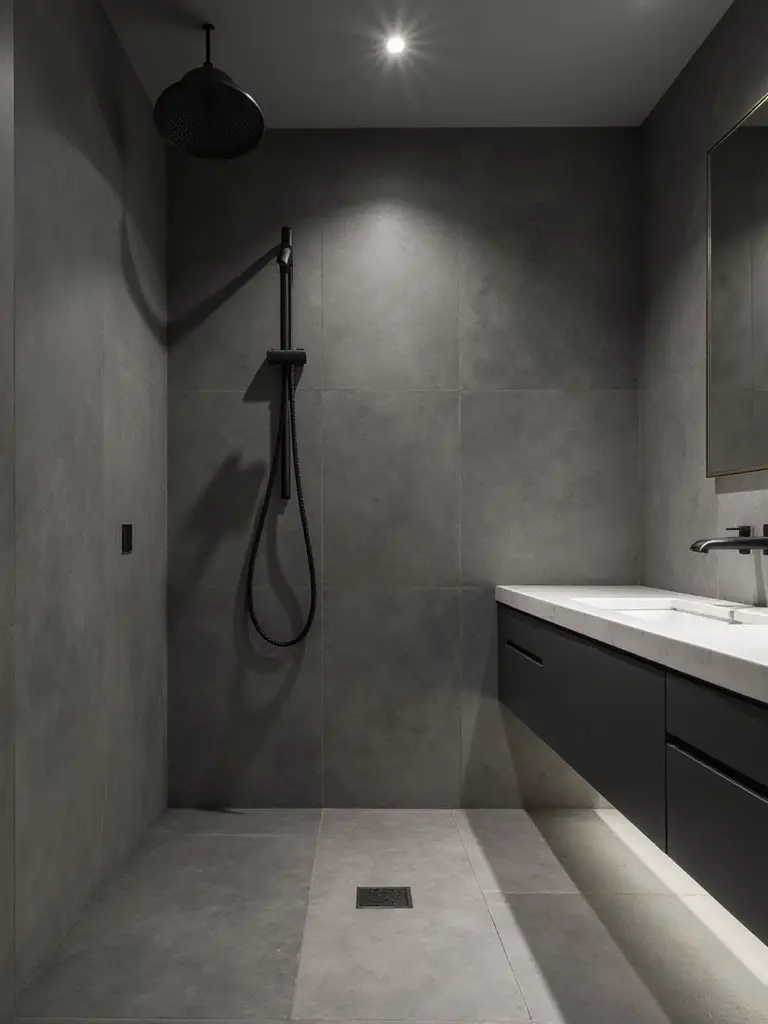
The practical upside is huge. Matte finishes are far better at hiding fingerprints, water spots, and dust than their glossy counterparts. You spend less time wiping things down. They provide a sense of calm both visually and practically. It’s a sophisticated choice that values soft diffusion of light over harsh, glaring reflections. A simple swap from polished chrome to matte black can make an entire room feel more grounded.
And with all these beautiful surfaces, the last thing you want is to cover them in clutter.
9. Opt for Concealed Storage to Maintain Visual Cleanliness
Your goal is an uncluttered countertop and a clear mind. The only way to achieve that is with thoughtful, concealed storage. This goes beyond just shoving things into a vanity. It means designing storage for the things you actually own. A tall, shallow cabinet for electric toothbrushes? Pull-out drawers with built-in dividers for makeup? A recessed medicine cabinet hidden behind a mirror? Yes.
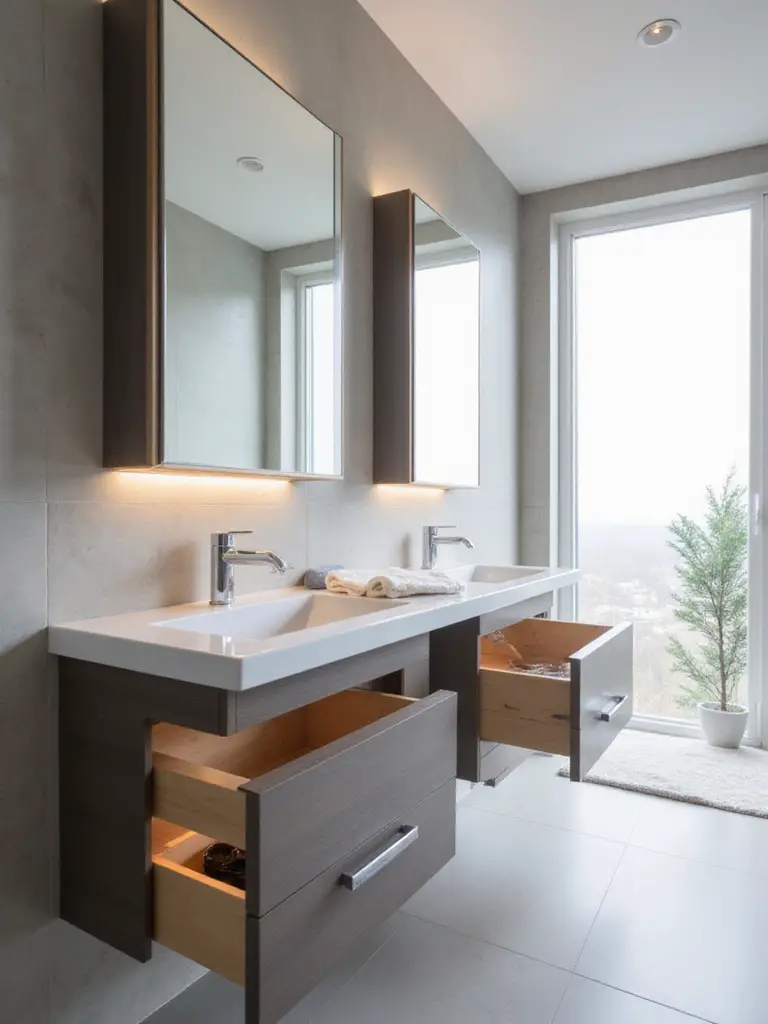
I had a client who was a master of organization. She had all these little bins and trays, but her counter was still a mess. We built a custom floor-to-ceiling cabinet, just 8 inches deep, with an outlet inside. All her daily items now live there, organized and out of sight. Her bathroom feels like a spa. Remember Kanso? The goal isn’t just to hide your stuff, it’s to create an environment where your mind can be still because it’s not being asked to process visual clutter.
With the room’s physical objects in order, we can turn our attention to its most important ephemeral element: light.
Strategic Lighting & Color Palette Creation
Light is a material. How you shape it, color it, and reflect it will define the entire mood of your sanctuary. This is where a bathroom truly becomes a dynamic space.
10. Implement Layered Lighting for Functional Ambiance
One ceiling light is not a lighting plan. It’s a recipe for a dreary, shadowy room. A modern bathroom needs layers of light for different purposes. This isn’t complicated. You just need three:
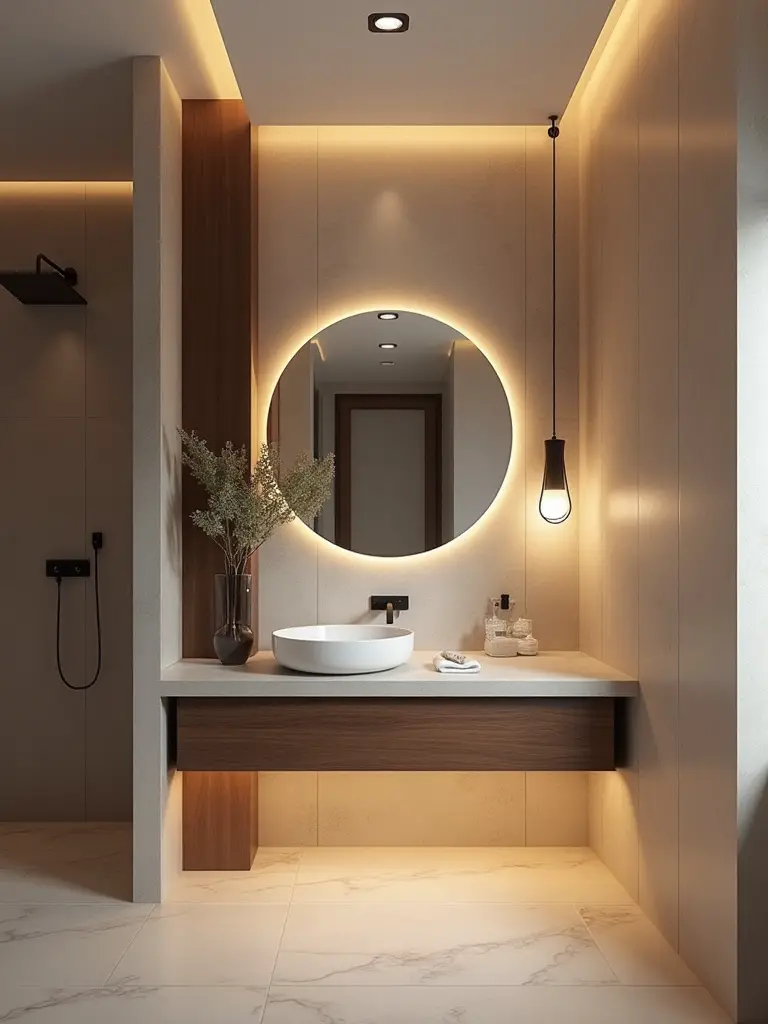
- Ambient: This is your general, overall light. Recessed LEDs on a dimmer are perfect.
- Task: This is focused, bright light for doing things. Think sconces on either side of the mirror to eliminate shadows on your face.
- Accent: This is the magic. A small spotlight on a piece of art, or an LED strip under a floating vanity. It creates mood and depth.
The non-negotiable shortcut? Put every single layer on a separate dimmer switch. This is the key to creating “functional ambiance.” You can have it bright and energetic in the morning, and soft and serene for a bath at night. You are giving yourself complete control over the energy of the room.
But no artificial light can ever replace the real thing.
11. Maximize Natural Light for Bright, Airy Spaces
Natural light is life. It’s the most valuable asset in any room, and it’s free. Your first job is to protect it. Don’t put up heavy curtains. Use frosted film or top-down/bottom-up shades for privacy. If you have a small window, make the mirror opposite it as large as possible to bounce that light around the room.
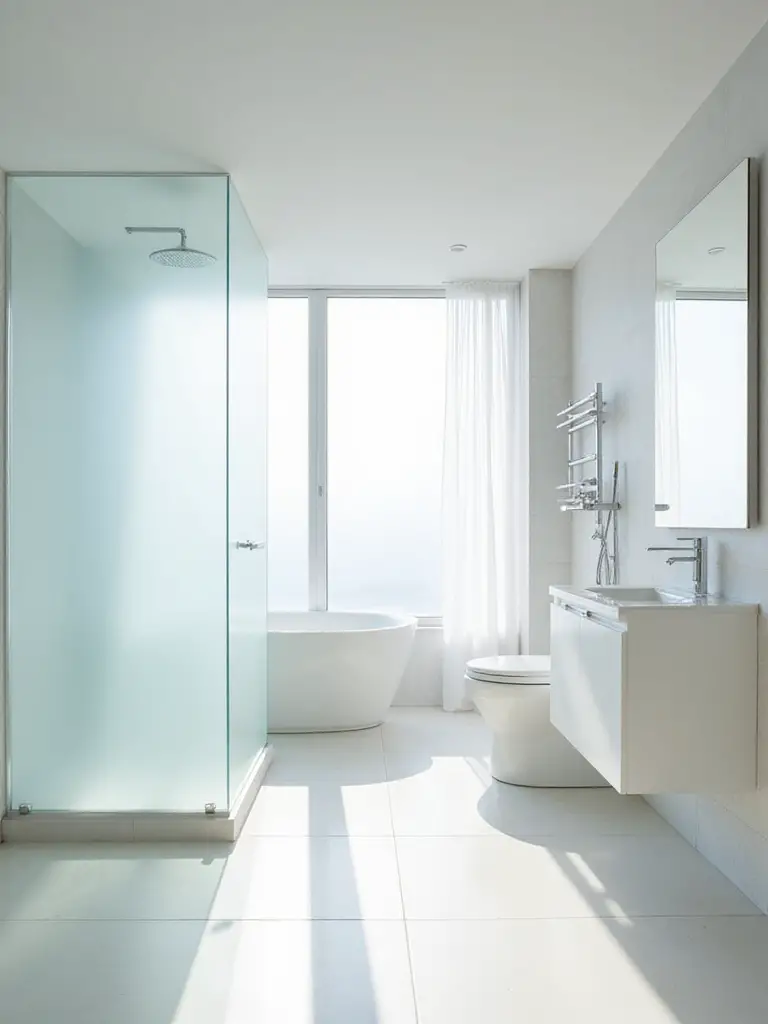
For interior bathrooms with no windows, there’s a brilliant solution: a solar tube. It’s like a miniature, highly reflective skylight that can pipe natural daylight down from the roof into a windowless space. I’ve seen them completely transform dark, sad little powder rooms into bright, welcoming spaces. Treat natural light like the precious resource it is. It connects you to the time of day and the world outside, grounding you in a way no lightbulb can.
Natural light plays beautifully across a unified color scheme.
12. Adopt a Monochromatic Palette for Understated Elegance
A monochromatic scheme—using different shades, tints, and tones of a single color—is the master’s path to sophistication. When you remove the distraction of multiple competing colors, something amazing happens: you start to see texture, form, and the way light creates shadows. It’s an incredibly calming and immersive experience.
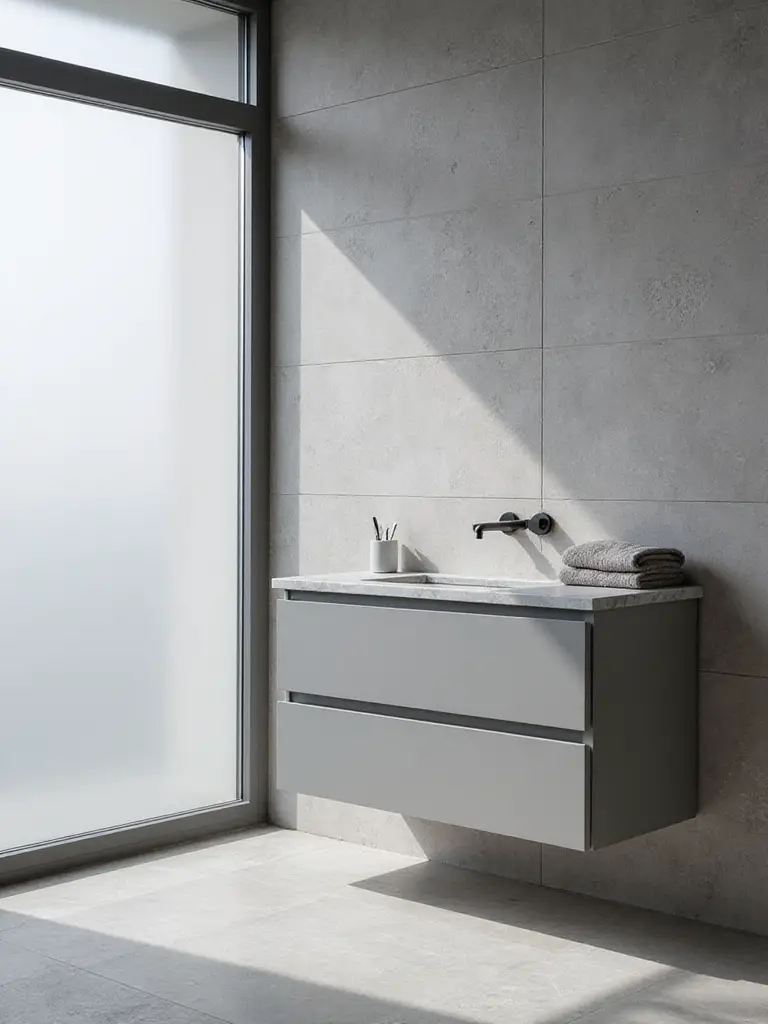
A bathroom done in varying shades of grey, for instance, can feel like a serene, foggy morning. You can have dark grey slate on the floor, medium grey tiles on the wall, a light grey vanity, and charcoal grey towels. It’s not boring; it’s deep. It forces you to appreciate the subtle differences in materials and finishes. It’s a meditative approach to color that is profoundly restful.
Within this calm field, you can create a single point of focus.
13. Introduce Single Bold Accents for Striking Visual Interest
This is the principle of ma, the beauty of negative space. The power of a single bold accent doesn’t come from the object itself; it comes from the quiet space surrounding it. The emptiness is what gives the object its power. Don’t add five interesting things. Add one. A single, sculptural pendant light. A stunning, oversized piece of art. A freestanding tub in an unexpected black finish.

Everyone gets this wrong. They think more is more. They’ll add a statement light, and a patterned tile, and colorful towels, and the result is a visual shouting match. Choose one hero. Let it be the focal point. Give it room to breathe, and let all the other elements in the room be the quiet, supporting cast. This is confidence. This is restraint. And it is the secret to high-impact design.
To amplify both light and your chosen accent, use reflection wisely.
14. Utilize Reflective Surfaces to Expand Perceived Space
Mirrors are magic. They aren’t just for checking your reflection; they are tools for manipulating space and light. A large, frameless mirror doesn’t just make a room feel bigger—it can literally double the light and create an illusion of infinite depth. Placing a mirror across from a window is the oldest and best trick in the book.

But don’t just think about mirrors. Reflective surfaces can be polished chrome fixtures that catch the light like jewelry. They can be glossy tiles that bounce light around a dark corner. Or, most powerfully, a frameless glass shower enclosure. By removing the visual barrier of a frame or a curtain, you allow the eye—and the light—to travel all the way to the back wall, making the entire room feel like one large, open space.
Now, let’s fill this beautiful, light-filled space with fixtures that honor its principles.
Selecting Sleek Fixtures & Furnishings
Every object you place in the room should be a perfect marriage of form and function. These are the tools you interact with every day, so they must be both beautiful to look at and effortless to use.
15. Install Floating Vanities for an Open, Weightless Look
A floating vanity is one of the most impactful choices you can make in a modern bathroom. By lifting the cabinet off the floor, you create an uninterrupted floor plane, which instantly makes the room feel larger, airier, and lighter. Energy—and a vacuum cleaner—can flow freely underneath. It’s a game-changer, especially in small spaces.
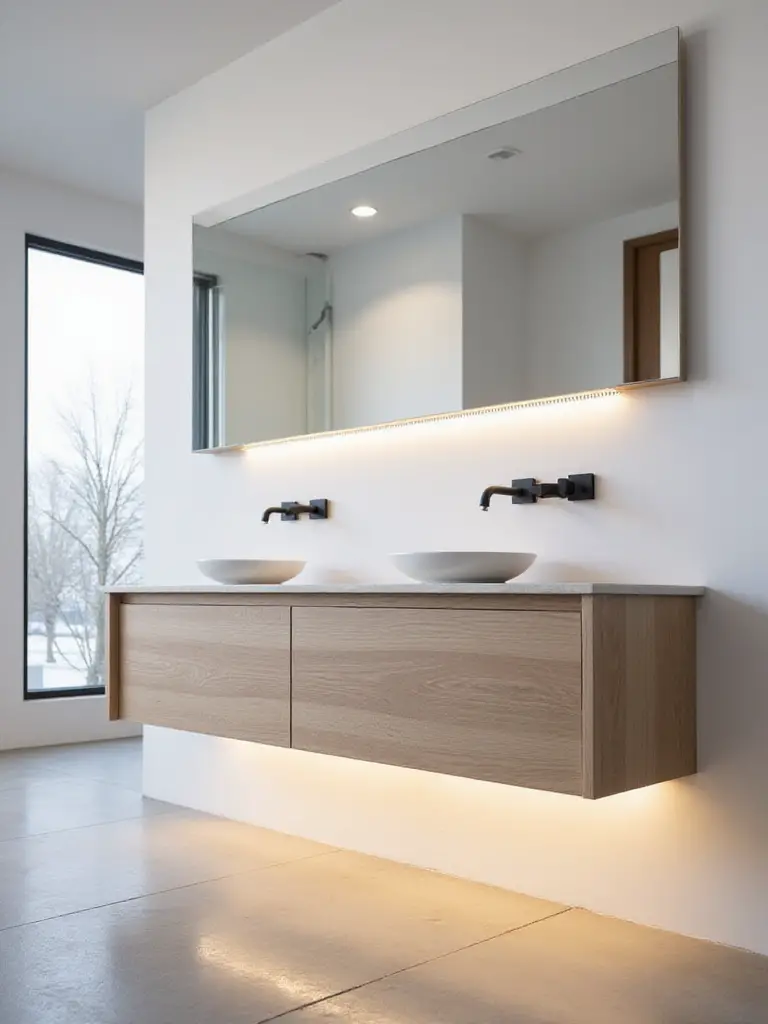
Here’s the hard-won shortcut: you absolutely must plan for this before the drywall goes up. A heavy floating vanity needs solid wood blocking installed between the wall studs to support its weight. If you try to hang it on drywall alone, you’ll have a very expensive crash in your future. Tell your contractor about your plan for a floating vanity from day one. It’s a small step in construction that makes all the difference.
The same principle of lightness applies to your faucet.
16. Choose Wall-Mounted Faucets to Enhance Modern Cleanliness
Lifting the faucet off the counter and mounting it on the wall is a master stroke of modern design. It creates a completely clear, uncluttered countertop that is incredibly easy to wipe clean. There’s no faucet base to collect gunk, hard water stains, and mildew. It’s a choice that is both visually and hygienically superior.
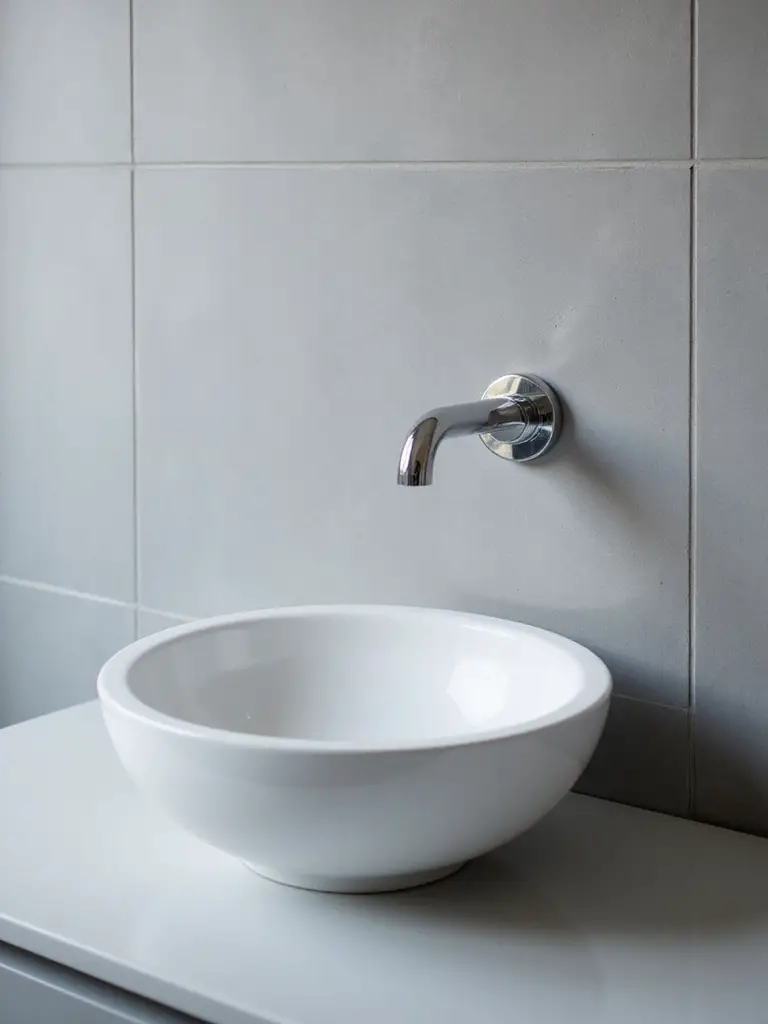
This creates a clean, sculptural look, where the water appears to flow directly from the wall. But just like a floating vanity, this requires early planning. The plumbing—specifically the valve—has to be installed inside the wall before any tile or finish work is done. It’s a commitment, but the payoff in terms of both minimalist aesthetics and practical cleanliness is enormous.
This sense of uninterrupted space continues with your shower.
17. Design a Frameless Glass Shower for Expansive Views
A shower curtain or a heavy-framed glass door chops a bathroom in half visually. A frameless glass enclosure, by contrast, practically disappears. It removes the barrier, creating one continuous, flowing space. Your beautiful tilework isn’t hidden; it becomes a feature of the entire room. Natural light can pass through unhindered.
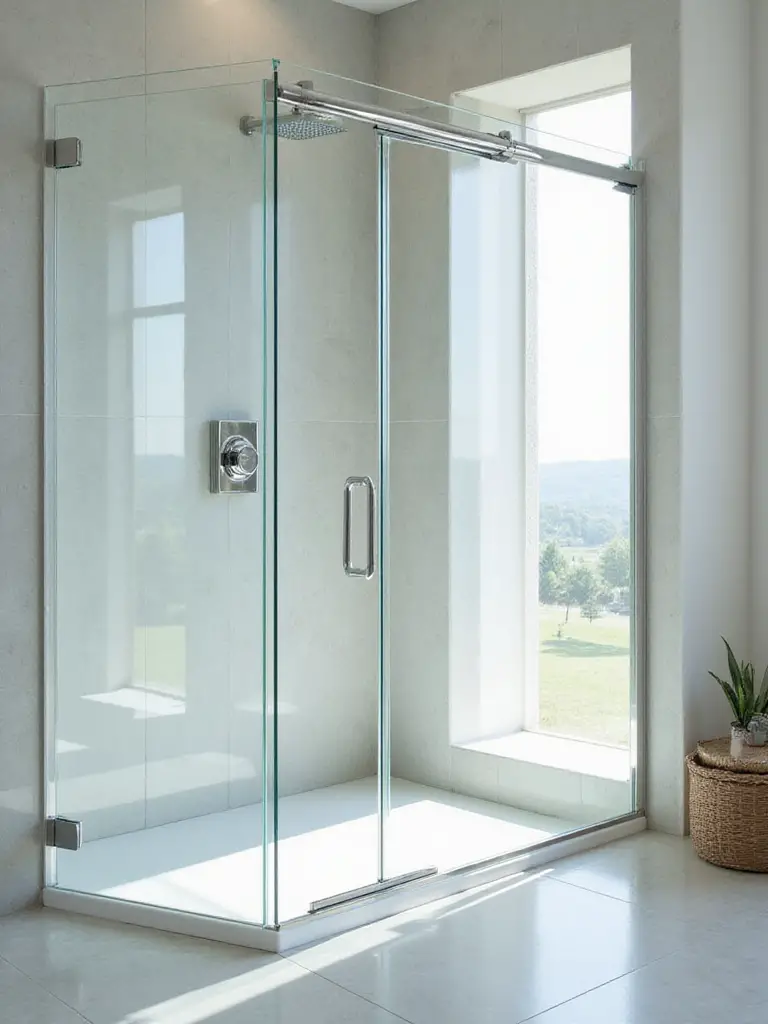
I learned this the hard way on an early project where we tried to save a little money with a semi-frameless door. That thin strip of metal at the top and bottom was all I could see. It compromised the whole design. For the full effect, invest in thick (3/8″ or 1/2″) low-iron glass. Standard glass has a slight green tint, but low-iron glass is almost perfectly clear, so the color of your tiles shows through true and bright.
The final piece of seamless design is the sink itself.
18. Select Integrated Sinks for Seamless Countertops
An integrated sink is the ultimate expression of seamless design. The sink is formed from the same piece of material as the countertop, creating one continuous, flowing surface. There are no seams, no rims, and no ugly caulk lines to collect grime. It’s the definition of clean, both visually and literally.
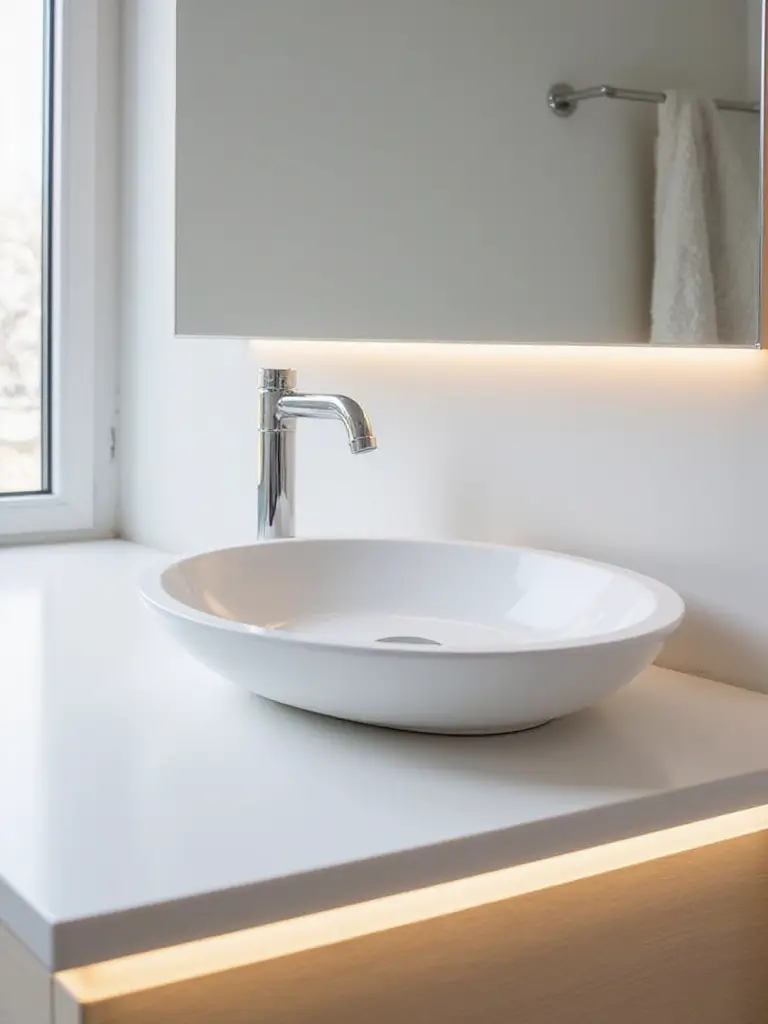
These are most common in solid surface materials like Corian or quartz. The effect is stunning—a smooth, unbroken plane that feels both minimalist and incredibly luxurious. Paired with a wall-mounted faucet, it is the peak of modern bathroom design. It represents a commitment to purity of form and function, where the transition from surface to basin is completely effortless.
With the core elements in place, it’s time for the final layers that make the space truly yours.
Elevated Details & Smart Enhancements
This is where you infuse the space with your personality and next-level functionality. These are the details that transform a well-designed bathroom into a personal sanctuary.
19. Incorporate Smart Mirrors for Enhanced Functionality
Now, we can talk about technology. A smart mirror isn’t about watching YouTube while you brush your teeth. It’s about mindful technology that serves your calm, not disrupts it. Imagine a mirror that gently displays the time, the weather, and your first calendar appointment. It gives you the key information you need without you ever having to pick up your phone and fall into the rabbit hole of email and social media.
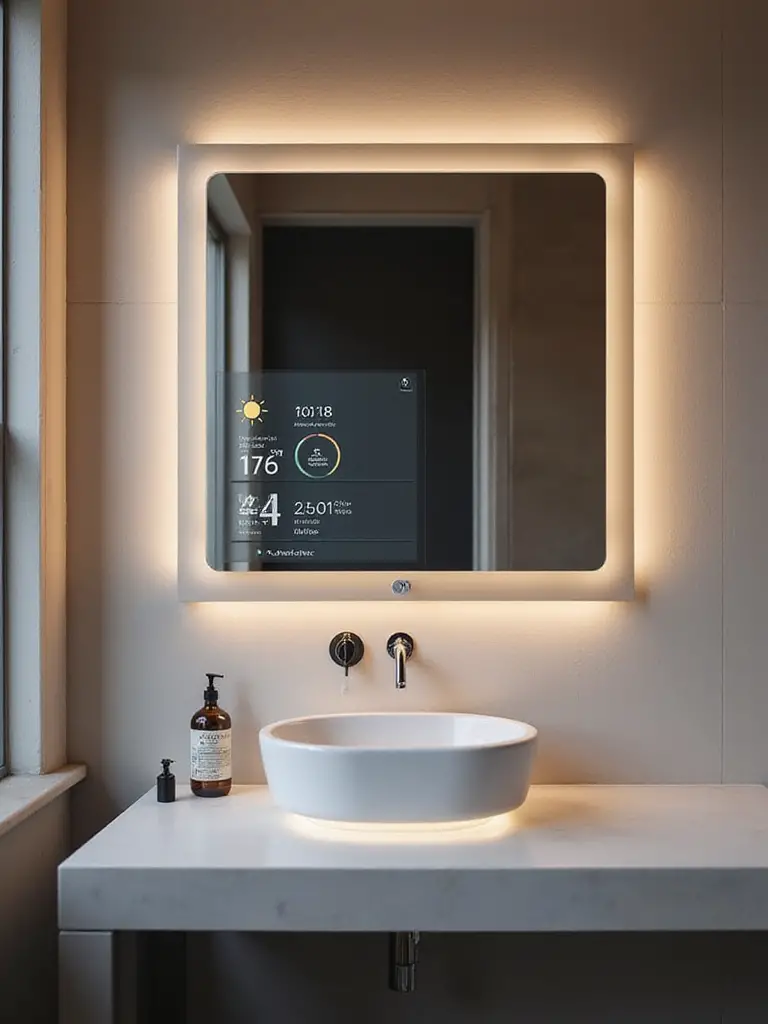
Some models have adjustable lighting, changing from bright, cool light for makeup application to a warm, soft glow for the evening. Many have built-in anti-fog heaters, which is a small luxury that makes a huge difference. The goal of technology in a zen space is to be seamlessly helpful. It should remove friction from your life, not add to it.
Once the tech is set, add a touch of soul.
20. Curate Purposeful Art to Express Personal Style
The bathroom is one of the most private rooms in your home, which makes it the perfect place for truly personal art. Forget generic hotel art. Choose a single piece that means something to you. It could be a photograph from a meaningful trip, a simple abstract painting with colors you love, or a small sculpture. This is the concept of wabi-sabi, finding beauty in simple, personal, and sometimes imperfect things.
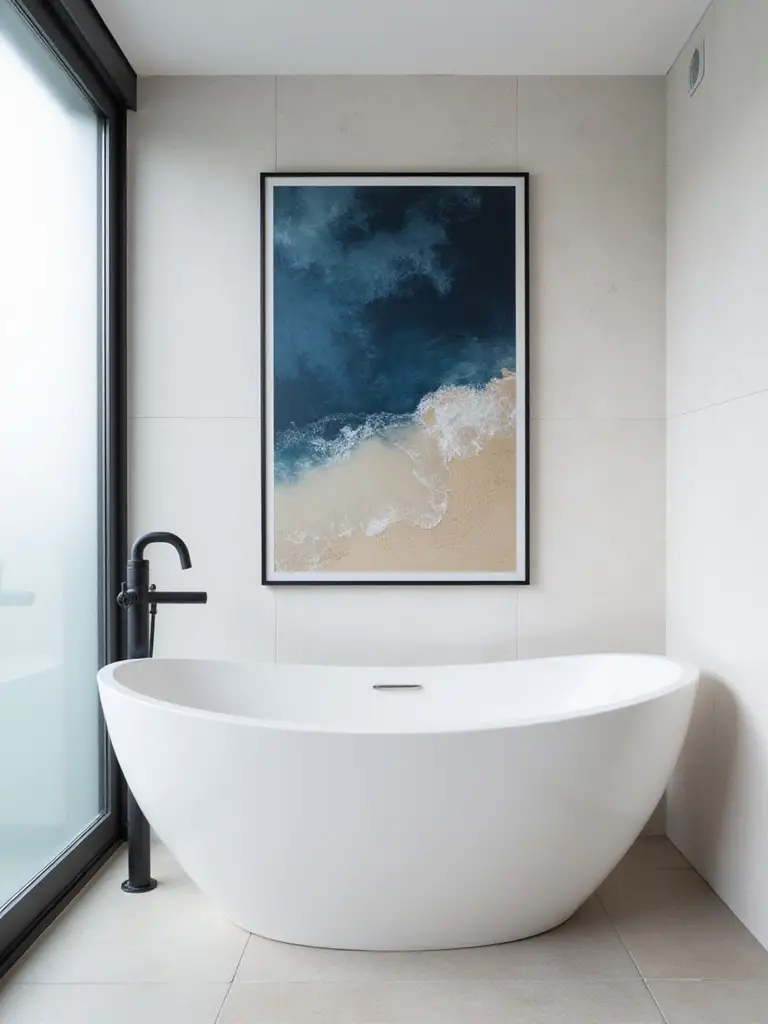
Place it where you’ll see it during a quiet moment—perhaps opposite the toilet or above the tub. A client of mine hung a simple, black-and-white ink wash painting of a forest in his bathroom. He said looking at it for thirty seconds while he brushed his teeth was his morning meditation. The art isn’t just decoration; it’s a focal point for contemplation.
Finally, bring in the element of touch.
21. Choose High-Quality Textiles for Luxurious Comfort
After all this attention to hard surfaces like tile and stone, the final touch is softness. Your towels, your bathmat, your robe—these are the things that actually touch your skin. This is not the place to save money. Investing in high-quality textiles transforms a daily routine into a small, luxurious ritual. The difference between a thin, scratchy towel and a thick, plush, highly absorbent one is profound.
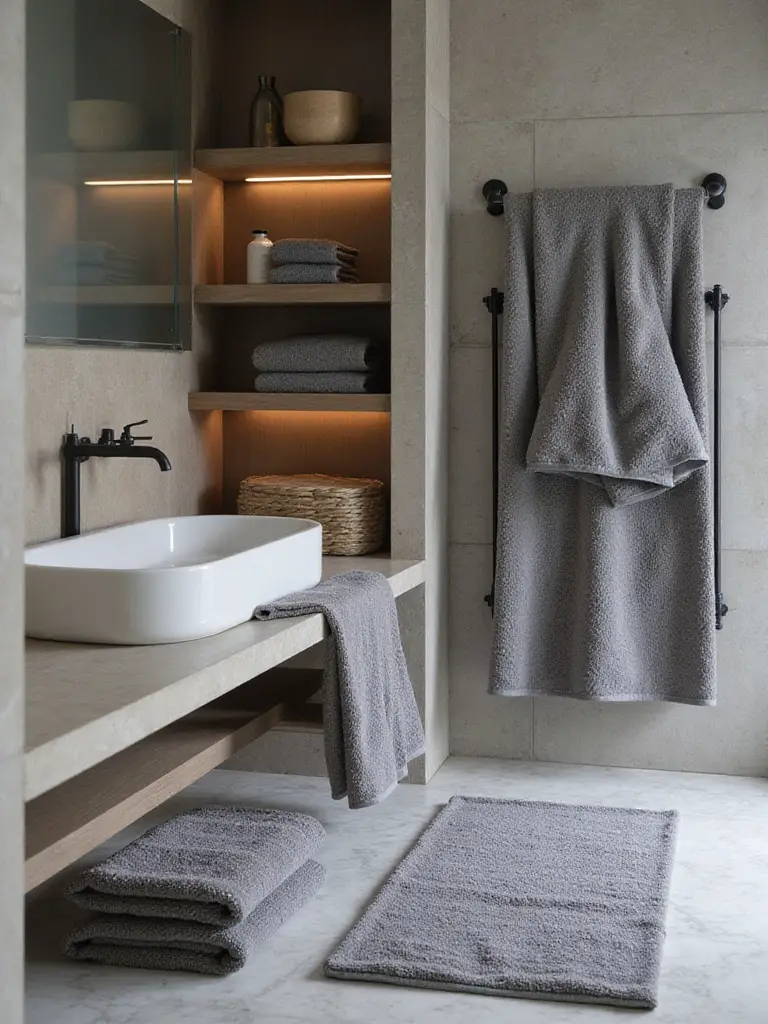
Look for high-GSM (grams per square meter) Turkish or Egyptian cotton towels. They are incredibly soft and absorbent and get better with every wash. Choose a color that complements your neutral palette. Storing them rolled on an open shelf or a simple wooden ladder adds a layer of soft, inviting texture to the room. This final sensory detail completes the transformation of your bathroom into a true sanctuary.
Conclusion
Creating a modern bathroom is not about a checklist of trendy items. It is an exercise in intention. It’s about understanding that every line, every material, and every ray of light has an effect on how you feel. It is the marriage of ancient wisdom about calm and modern design that serves our busy, digital lives.
Your bathroom is the first room you enter in the morning and the last one you leave at night. By designing it as a place of quiet, clarity, and effortless function, you are giving yourself a powerful gift. You are building a space that supports your well-being, calms your mind, and prepares you to engage with the world—or retreat from it—with a renewed sense of peace. That is the true meaning of a modern sanctuary.
